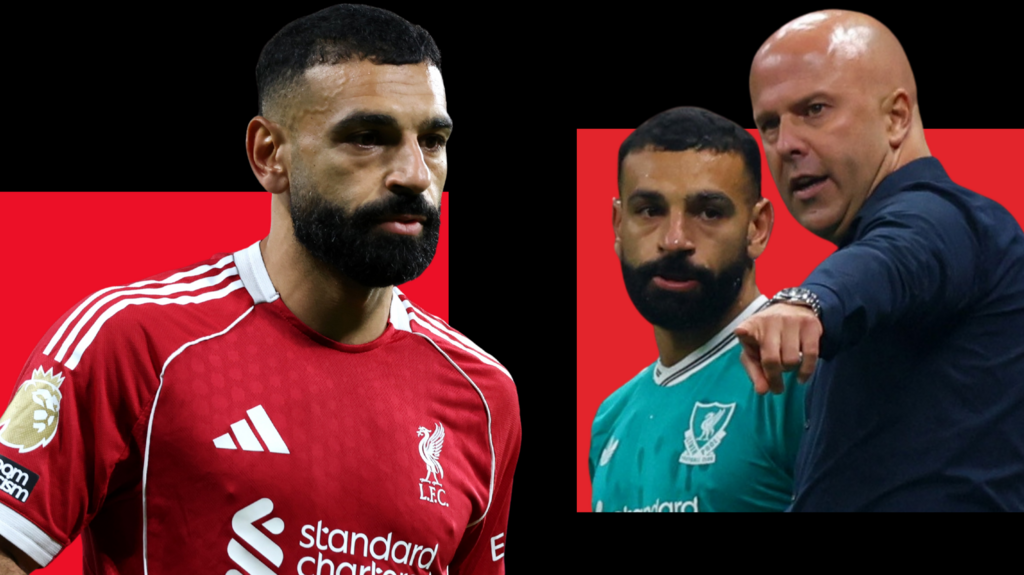Mohamed Salah’s perceived lack of defensive contribution appears to be emerging as a tactical concern for Liverpool, particularly against top-tier opposition.
It is plausible that manager Arne Slot has instructed Salah to prioritize his attacking position on the right flank, a strategy that has historically yielded significant goal-scoring returns.
However, the defensive support behind Salah seems inadequate, creating vulnerabilities for the right-back throughout the season.
Whether it be Jeremie Frimpong, Conor Bradley, or Dominik Szoboszlai, the right-sided player often faces a challenging 2v1 situation, exposing the team’s defensive structure.
This weakness was evident in Saturday’s match, contributing to Chelsea’s winning goal, and raises concerns about future exploitation by astute opponents.
On several occasions during the game, Salah did not track Marc Cucurella’s runs from Chelsea’s half into Liverpool’s defensive area.
It is unlikely that Slot is directing Salah to consistently track back and support the right-back.
If Salah were instructed to follow Chelsea’s left-back, Marc Cucurella, his failure to do so would be glaringly obvious and likely unacceptable to Slot.
Instead, Slot may be granting Salah the freedom to conserve energy for attacking plays, a strategy employed by various teams with players focused on offensive output.
Of course, there are pivotal moments in a match where individual responsibility and defensive effort are crucial, even for attacking players.
Salah has demonstrated his defensive capabilities, notably in Liverpool’s victory against Manchester City last season, where his defensive contribution was exceptional.
This suggests that he can execute defensive duties when specifically instructed, absolving him of blame if the current strategy prioritizes his attacking role.
The core issue lies in Liverpool’s overall defensive setup behind Salah, particularly when facing stronger teams.
Greater and more rapid support from other players is essential, as Chelsea appeared to deliberately exploit the space on Liverpool’s right flank.
Delayed intervention from Liverpool’s midfielders, such as Ryan Gravenberch or Alexis Mac Allister, left gaps in front of the defense, compromising the team’s central stability.
This problem is less pronounced against teams that Liverpool dominates, as evidenced by their past league success with this approach; however, adjustments are necessary to prevent exploitation by top-tier opponents.
A significant portion of Chelsea’s attacks – 39% – originated from Liverpool’s right flank.
While Salah’s role hasn’t fundamentally changed this season, his perceived defensive shortcomings are amplified by his current goal-scoring drought.
His form is not a major concern, as his finishing prowess is likely to return.
Against Chelsea, he found himself in promising positions but occasionally made suboptimal decisions regarding passing versus shooting; however, these opportunities will persist, and goals will follow.
The more pressing issue for Liverpool is the diminished control over games compared to the previous season.
The recent week has been disappointing, marked by three consecutive losses in the Premier League and Champions League, compounded by underwhelming performance levels.
This video can not be played
How Chelsea exploited Liverpool’s full-backs
Several factors contribute to this, including personnel changes during the summer and players missing pre-season training. However, under Slot, last season’s Liverpool team exhibited exceptional game management, a quality that is currently lacking.
Their defensive shape appeared solid, and Slot’s possession-based style fostered greater control.
This was an immediate and noticeable improvement compared to Jurgen Klopp’s approach.
Currently, Liverpool’s play seems somewhat chaotic. The final half-hour of the Chelsea game felt like a cup tie, with both teams creating numerous chances, ultimately leading to Liverpool’s defeat.
This video can not be played
Fine margins just not in our favour at the moment- Slot
Several issues plague Liverpool, including frequent turnovers, but the situation is not irreparable.
The introduction of new players, even those with different skill sets, should not necessitate a complete change in playing style. Instead, Liverpool needs to regain patience and composure.
The positive news is that they remain just one point behind league leaders Arsenal and have time to address these issues.
The missing physical element will improve as players such as Alexander Isak, Mac Allister, Bradley, and Hugo Ekitike, who lacked proper pre-season training, reach peak fitness.
Developing on-field relationships, whether between the right-back and Salah or Florian Wirtz and Isak, requires time and repetition.
Therefore, panic is unwarranted. In the current Premier League climate, teams are often only one week away from perceived ‘catastrophe’ and intense criticism.
The challenges Liverpool has faced this week are likely to be experienced by Arsenal and Manchester City at some point this season.
Initially, Manchester City was not considered a title contender, but Erling Haaland’s form and fitness make them a formidable threat.
Arsenal’s defense remains strong, and after seven games, they appear comfortable and confident, building upon last season’s foundation with added quality and depth.
Liverpool, in contrast, seems to be undergoing more of a rebuild. While they strive to find the right balance and combinations, improvement is expected as the season progresses.
Danny Murphy was speaking to BBC Sport’s Chris Bevan.
Comments can not be loaded
To load Comments you need to enable JavaScript in your browser

